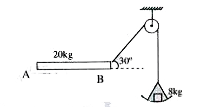What force, in newton, your muscles need to apply to hold a mass of 5 kg in your hand ? State the assumption.
To determine the force your muscles need to apply to hold a mass of 5 kg in your hand, we can follow these steps:
1. Identify the Given Values:
- Mass (m) = 5 kg
- Acceleration due to gravity (g) = 9.8 m/s² (this is a standard value on the surface of the Earth)
2. Use the Formula for Force:
- The force (F) exerted by an object can be calculated using Newton's second law of motion:
F=m⋅a
- In this case, since we are holding the mass, the acceleration (a) is equal to the acceleration due to gravity (g).
3. Substitute the Values into the Formula:
- Substitute the mass and the acceleration due to gravity into the formula:
F=5kg⋅9.8m/s2
4. Calculate the Force:
- Performing the multiplication:
F=5⋅9.8=49N
5. Conclusion:
- The force your muscles need to apply to hold a mass of 5 kg in your hand is 49 Newtons.
Assumption:
- The assumption made in this calculation is that the acceleration due to gravity is constant and equal to 9.8 m/s².
- Mass (m) = 5 kg
- Acceleration due to gravity (g) = 9.8 m/s² (this is a standard value on the surface of the Earth)
- The force (F) exerted by an object can be calculated using Newton's second law of motion:
F=m⋅a
- In this case, since we are holding the mass, the acceleration (a) is equal to the acceleration due to gravity (g).
- Substitute the mass and the acceleration due to gravity into the formula:
F=5kg⋅9.8m/s2
- Performing the multiplication:
F=5⋅9.8=49N
- The force your muscles need to apply to hold a mass of 5 kg in your hand is 49 Newtons.
- The assumption made in this calculation is that the acceleration due to gravity is constant and equal to 9.8 m/s².
Topper's Solved these Questions
- LAWS OF MOTIONBOOK - ICSECHAPTER - LAWS OF MOTIONEXERCISE - EXERCISE - 3(E) (Multiple choice type)
5 Videos
- ICSE ANNUAL EXAMINATION -2020BOOK - ICSECHAPTER - ICSE ANNUAL EXAMINATION -2020EXERCISE - SECTION-II
45 Videos
- LIGHTBOOK - ICSECHAPTER - LIGHTEXERCISE - TOPIC 2 Spherical Mirrors (4 Marks Questions )
9 Videos
Similar Questions
The areas of pistons in a hydraulic machine are 5cm2 and 625cm2. What force on the smaller piston will support a load of 1250 N on the larger piston ? State any assumption which you make in your calculation.
View SolutionWhat kind of contraction occurs in your neck muscles while you are reading your class assignment?
View Solution(a) What length of water column is equivalent to 0.76 m of mercury column ? State the assumption made in your calculation.
(b) Can water be used as barometric liquid ? Give a reason.
View SolutionA block of mass m=2kg is resting on a inclined plane of inclination 30∘ as shown in figure The coefficient of friction between the block and the plane is μ=0.5 what minimum force F (in newton) should be applied perpendicular to the plane on the block so that the does not slip on the plane?

View SolutionA block of mass m=2kg is resting on a inclined plane of inclination 30∘ The coefficient of friction between the block and the plane is μ=0.5 what minimum force F (in newton) should be applied perpendicular to the plane on the block so that the does not slip on the plane?

View SolutionTwo masses 5kg and 2kg connected by a string are at rest on a smooth horizontal surface. A con stant force IN is applied on 5kg mass as shown in the figure. Two seconds later the string connecting the masses is cut but 'F' continues to act. After two more seconds

View SolutionYou are driving your bicycle at a fast speed. Suddenly, a small boy comes in front of your cycle and without wasting any time in thinking, you immediately apply the brakes and the accident is avoided. What name is given to such an action?
View SolutionCalculate the work done by a porter holding a suitcase weighing 5 kg in his hand.
View SolutionA force of 10 Newton acts on a body of mass 20 kg for 10 seconds. Change in its momentum is
View SolutionA horizontal uniform beam AB of length 4m and a mass of 20 kg is supported at the end B by means of a string which passes over a fixed, smooth pulley supporting a counterbalancing weight of 8 kg on the other side. What force, F when applied at the point A in a suitable direction, will hold the beam in static equilibrium ?

View Solution
